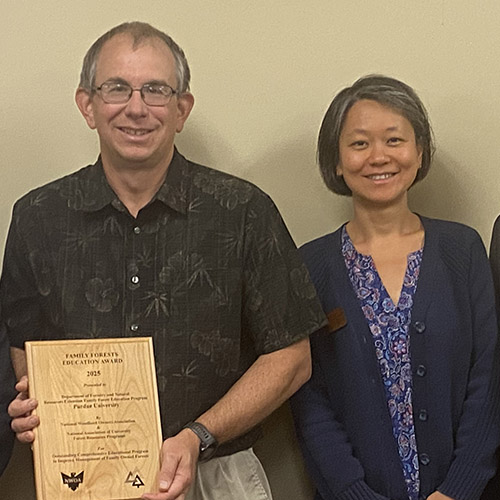New Videos Stress Importance of Young Forests
New videos released by the Ruffed Grouse Society and the U.S. Forest Service discussing the importance of young forests for wildlife habitat, forest regeneration, and more feature several FNR faculty/staff members and alumni.
The Ruffed Grouse Society video, which features Purdue Extension forester Lenny Farlee (BS 1985, MS 1991) and 2001 wildlife alumna Brianne Lowe, was produced in conjunction with the United States Department of Agriculture and Natural Resources Conservation Service, the Indiana Society of American Foresters, the Indiana Association of Consulting Foresters, the Indiana Department of Natural Resources, Purdue Extension, the Indiana Forestry Educational Foundation, Tri-State Timber, Baird Sawmill, the Indiana Hardwood Lumberman's Association, Ricer Equipment, Seitzinger Forestry, and the Midwest Conservation Group.
"The information presented in the video aligns with the research work and results being found from the Hardwood Ecosystem Experiment project and also represents a significant resource management challenge that flies under the radar for many," Farlee said.
Patrick Ruhl, who earned his master's (2014) and Ph.D. (2018), studying wildlife science under Dr. Barny Dunning, filmed the video of ruffed grouse included in the young forests video while doing research on the Hardwood Ecosystem Experiment during his time at Purdue. Ruhl is now an assistant professor at Harding University.
In addition to being available online, the Ruffed Grouse Society video also is being shown as part of the Woods on Wheels display in order to emphasize the importance of forest management to develop and retain a diversity of plant and animal life in the Indiana forested landscape.
The U.S. Forest Service videos "What is Young Forest?" and "Who Needs Young Forest?" feature Purdue Extension wildlife specialist Jarred Brooke along with former FNR student Travis Swaim, a forest silviculturist on the Hoosier National Forest. Amy Spalding, a forester for the National Forestry Initiative with the National Wild Turkey Foundation, and Kyle Brazil, Central Hardwoods Joint Venture Conservation Delivery Coordinator for the American Bird Conservancy round out the contributors to the video.
"A young forest is a fresh start, a new beginning on a forest," Brooke explained. "These forests provide an abundance of food and cover for a variety of wildlife species because of their thick vegetation and high plant diversity."
Find out more about the impacts of timber harvesting and the creation of young forests on plant and animal species by visiting The Hardwood Ecosystem Experiment website. More than 70 publications, available on the HEE website, are related to the responses to young forest management.
Resources:
Harvesting our forests, the wildlife debate by Brian MacGowan
Wildlife Responses to Timber Harvesting
Hardwood Ecosystem Experiment – Forest Birds
Managing Woodlands for Birds
Sustaining Our Oak-Hickory Forests
Breeding Birds and Forest Management: the Hardwood Ecosystem Experiment and the Central Hardwoods Region
Forest Management for Reptiles and Amphibians: A Technical Guide for the Midwest
Hardwood Ecosystem Experiment publications
Ask the Expert: Hardwood Ecosystem Experiment - Birds and Salamander Research
Hardwood Ecosystem Experiment Highlights: Breeding Birds
Hardwood Ecosystem Experiment Highlights: Small Mammals
Hardwood Ecosystem Experiment Highlights: Salamanders
Hardwood Ecosystem Experiment Highlights: Moths
Hardwood Ecosystem Experiment Highlights: Bats
Hardwood Ecosystem Experiment: How the HEE Came to Be






